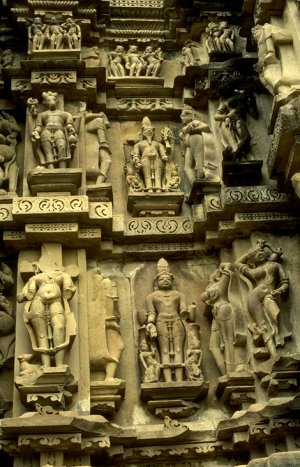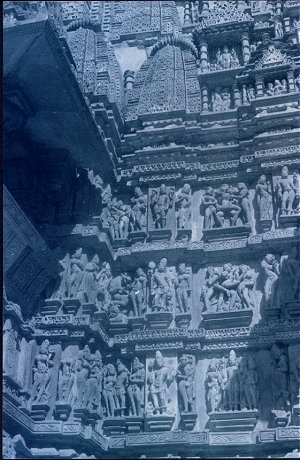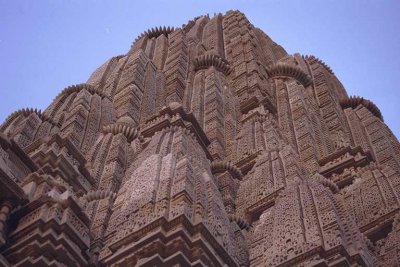Temples of Khajuraho
One of the most developed and refined expressions of Indo-Aryan genius is to be found in the group of temples at Khajuraho in Madhya Pradesh. Of the eighty-five temples originally built by Rajputs who ruled between the 9th and the13th centuries, only about thirty still exist. These however are well preserved, considering that they have been neglected for nearly a thousand years. Unlike the temples in Orissa, these shrines are not the result of a slow, concerted development spread over several centuries, but rather a brilliant, although comparatively short, phase in Hindu temple architecture wherein intense religious feeling and aesthetic talent combined to produce buildings of great significance.

Erotic sculptures of Khajuraho
A unique feature of the Khajuraho temples is that, contrary to custom, they are not enclosed within walls, but stand on a high terrace of solid masonry, as though in an effort to rise above their temporal surroundings. In addition, the constituent parts are not built as separate units but present an architectural synthesis of striking unity. The Khajuraho temples are, however, not as imposing in size as the Orissan, but achieve the same grandeur through their graceful proportions and superb surface decoration. The largest of these is only about a hundred feet in length. As a rule there are three main compartments, namely, the garbhagriha, the mandapa and the ardhamandapa or entrance portico, arranged in the fashion of a cross. The antarala, the mahamandapa or the transepts and the perambulatory passage supplement the other compartments in the more developed examples. The aspiring quality associated with most styles of temple architecture is emphasized in the Khajuraho group to a marked degree. The entire mass of granite or sandstone, of which most of these are constructed, appears to have an upward movement, the effect of loftiness being further enhanced by a number of pronounced vertical projections. The range of open porches with overhanging eaves running horizontally around the temple serves to let in light, thus throwing a band of vivid shadow over the entire composition.
The exterior of the temples, decorated with parallel friezes in high relief, displays a rare wealth of human and divine forms, pulsating with life and warmth, moving in a pageant of unending variety and presenting themes of inexhaustible interest. The graceful animation of these lifelike forms, the consummate skill with which they are executed on the stone walls, and the vast variety and ingenuity of the techniques employed are unparalleled in any other similar style of temple architecture. The tenuous, flowing lines of the shikhara give it an elegant and refined quality which the Orissan shikharas do not possess in the same degree. The solid strength of these temples becomes infused with fresh beauty on account of the graceful shikharas. In sharp contrast with the austerely simple interiors of the Orissan temples, the halls at Khajuraho are richly carved. In addition to the oversailing courses of masonry the richly sculptured ceiling is supported by four pillars -one at each corner of the hall - which bear heavily ornamented bracket capitals. The pillars are carved above and below with grotesque figures of dwarfs and griffins. In the spaces in-between are statuettes of sculptured feminine forms in attitudes of enchanting grace and loveliness. The sharp contrast presented by the forbidding appearance of the former and the pervasive beauty of the latter perhaps symbolizes the triumph of beauty over ugliness, or that of the spiritual over the bestial.
Corel Professional Photo

Carvings at a Khajuraho temple
As in the wall sculptures of the Orissan temples, eroticism is a recurrent theme in the shrines at Khajuraho. Various theories have been advanced to account for this, but the commonly accepted explanation is that the many erotic groups depicted here with such abandon represent, the mithuna ritual of the Tantric cult, according to which personal salvation can be attained only through experience: both sensual and spiritual. Another belief is that, being a powerful human experience signifying complete fulfillment through union, the sexual experience here symbolizes the fusion of the individual with the divine. Yet another theory holds that since such sculptures are usually found on the exterior surfaces of a temple and are absent from the interior, it may be concluded that they are meant to test the devotion of the worshipper or to warn him against entering the sanctum until he has conquered carnal desire. Whatever the significance of these sculptures may be, it is fairly clear from their intrinsic artistic merit that the sculptors who fashioned them found the temple walls an easy canvas for the depiction of such an elemental theme as love between man and woman.
The twelve Vaishnava and Shaiva temples to the northwest of the site form the most important of the groups at Khajuraho. Among these is the Shiva shrine of Kandariya Mahadev, the largest and most representative of all the Khajuraho temples. Planned like a double armed cross, this temple has an air of vibrancy attributable as much to the masterly skill with which the various parts of the temple are related, as to the superb gallery of sculptures which embellishes its walls.
K.L.Kamat

Erotic Sculpures on the Chandela Temples
Khajuraho, Madhya Pradesh
Built on the same principle as the Kandariya Mahadev, but much smaller, are the Shiva temple of Vishvanath and the Vishnu temple of Chaturbhuj. The former is believed to have been built around 1000 A.D. and both are of the panchayatana type. Facing the Vishvanath temple and built on the same platform is a small temple which houses a colossal statue of Nandi, Shiva's bull. The temple of Devi Jagadamba, now dedicated to the goddess Kali, was originally a Vishnu shrine. There were four additional shrines, which are characteristic of panchayatana temples, but these have now disappeared. The Chhattr-ka-patr temple is dedicated to Surya, the Sun-God, and is noted for its elegant proportions. Another notable temple is dedicated to Varaha, the boar incarnation of Vishnu, a large sculptured figure which is installed in the center. The Matangeshwara and Parvati temples are also notable examples of the northwestern group at Khajuraho.

Temple sculpture, Khajuraho
Basically similar to the Brahmanical temples, the Jain temples grouped together on the southeast of the site are remarkable in that there is an almost complete absence of window openings which characterize the foregoing group. The parallel friezes of the statuary relieve the monotony of the walls to some extent. At intervals, portions project like buttresses from the sculptured friezes and are carved into pillared niches where the sacred images are enshrined.
The Parshwanatha is the largest and the most beautiful Jain temple at Khajuraho. The sanctum contains an ornamental throne and a sculptured bull, the emblem of Adinath, the first of the Jain Teerthankars. The modern image of Parshwanatha was installed late in the 19th century. It is significant that this Jain temple also houses images and sculptures of Brahmanical gods and goddesses, for it speaks of a spirit of tolerance not often seen in places of worship.
Corel Professional Photo

Temple Complex at Khajuraho
Northen Madhya Pradesh
A cluster of 12 pillars, standing a little apart from the main group, is all that remains of the Jain temple known as Ghantai, but these have attracted considerable attention on account of their Attic beauty. According to Percy Brown, it is "evidently the handiwork of a group of the most accomplished craftsmen of the time."
Along with Jain temples, this southeastern group also includes Brahmanical ones such as the Duladev and the Chaturbhuj. The Kunwar Math lying south of the Jain group near Kurar Nala is perhaps the finest example of this class. Remains of temples, belonging to the same period and of the same type, have been found, as far as Rewa State (e.g., the Visvanath temple at Maribag). Temples which may roughly be called Central Indian are found in various states of preservation situated all the way from Jabalpur to Jhansi, and as far as Orissa and Rajasthan. The Shiva temple at Baroli, believed to date from the 9th or 10th century, compares very well with contemporary structures in Orissa, both from the point of view of richness of design and fineness of sculpture.
_________________
First published as Temples of North India, Dept. Information and Broadcasting, Government
of India 1975. All rights reserved.
![]()
See Also:
-
Beauties of Khajuraho -- The temples of Khajuraho built in the tenth century contain stunningly explicit sexual sculptures.
-
Temples of India -- Detailed discussion on the history, and stylistics of some of the great temples of India.

